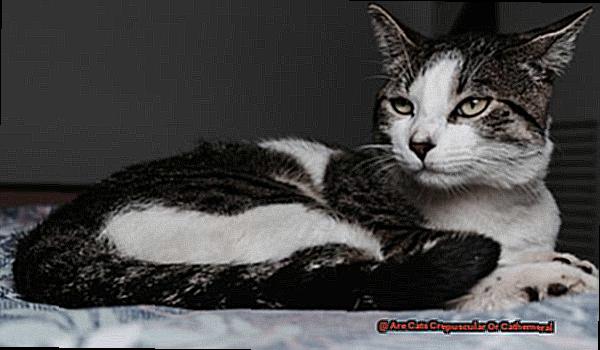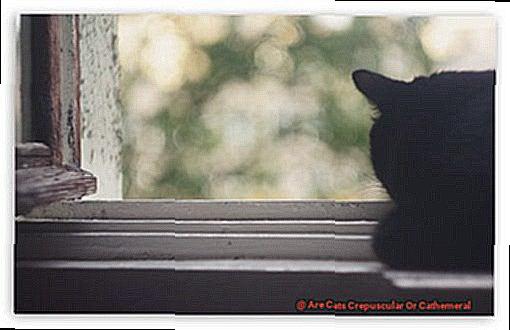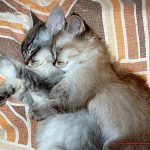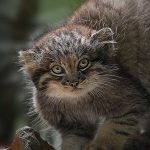Imagine this: the sun is just beginning to set, casting a warm glow over your backyard.
You’re lounging on a lawn chair, enjoying the last rays of sunlight when suddenly, your cat appears out of nowhere. They stretch and yawn before settling down next to you for some quality snuggle time.
But wait – weren’t cats supposed to be nocturnal creatures? This is where the debate between crepuscular and cathemeral cats comes into play.
So let’s delve into this intriguing topic and uncover the true nature of our feline friends’ sleeping habits.
Are Cats Crepuscular Or Cathemeral?
Contents
If you’re a cat owner, you may have noticed that your furry friend is most active during certain times of the day. You may have also heard terms like “crepuscular” and “cathemeral” being used to describe cats’ activity patterns. But what do these terms mean, and how do they relate to our feline companions? As an expert on cats, I’m here to shed light on this topic and help you better understand your cat’s behavior.
First, let’s define these terms. Crepuscular refers to animals that are most active during the twilight hours, around dawn and dusk. On the other hand, cathemeral animals have sporadic activity throughout the day and night. When it comes to cats, there has been much debate about whether they are primarily crepuscular or cathemeral. So which one is it?

The truth is, it depends on various factors such as personality, environment, age, breed, and health. In the wild, cats are known to be solitary hunters and are most active during twilight hours because that’s when their prey is also most active. This suggests that cats are naturally crepuscular animals. However, as domesticated pets, cats have adapted to their owners’ schedules and may be more active during the day when their humans are awake and interacting with them.
Another factor that can influence a cat’s activity pattern is their age. Kittens tend to have more energy and may be more active throughout the day, while older cats may prefer to rest and conserve their energy during certain times of the day. Additionally, certain breeds, such as Siamese and Bengal cats, are known to be more active and playful compared to others.
But it’s not just about natural instincts or breed traits; each cat is an individual with their own unique personality and preferences. Some cats may prefer to sleep during the day and be more active at night, while others may have a reverse pattern. It’s essential for cat owners to observe their pet’s behavior and understand their individual needs when it comes to activity levels.
The Debate: Are Cats Crepuscular or Cathemeral?
Adaptability and Environment: The Key Players
Cats are known for their adaptability, which has allowed them to thrive in various environments, from the wild to our homes. This adaptability also plays a role in their activity patterns. In the wild, cats are solitary hunters and are most successful during the early morning and evening hours when their prey is also most active. This has led some experts to argue that cats are primarily crepuscular animals.
On the other hand, domesticated cats do not have to rely on hunting for their food, as we provide them with regular meals. This can disrupt their natural instincts and make them more active at any time of the day or night. Additionally, factors such as weather, availability of food, and interactions with humans can also affect a cat’s activity levels throughout the day.
The Urban vs. Rural Divide
Researchers have found that cats living in urban areas tend to be more active at night, while those in rural areas may follow a more crepuscular pattern. This could be due to the noise and activity levels in cities that can disrupt a cat’s natural rhythm. On the other hand, cats living in rural areas may have fewer disturbances and can stick to their natural crepuscular behaviors.
The Human Factor
Another factor to consider is that domesticated cats may have adapted to their owners’ schedules and become more active during the day when their owners are home. This could be because they receive more attention and playtime during these hours. So if your cat loves to wake you up at the crack of dawn for some playtime, it could be a result of their domesticated tendencies rather than their natural instincts.
The Verdict: Crepuscular or Cathemeral?
Despite ongoing research and debates, the verdict on whether cats are crepuscular or cathemeral remains inconclusive. It ultimately depends on the individual cat’s behavior and environment. Some may lean towards a more crepuscular pattern, while others may exhibit cathemeral behaviors. As highly adaptable creatures, cats can adjust their activity patterns based on their surroundings and interactions with humans.
Factors That Affect a Cat’s Activity Pattern
We all know that our feline friends have a unique way of living their lives. They are finicky, independent, and sometimes downright mysterious creatures. Have you ever wondered why your cat is suddenly racing around the house in the middle of the night or why they seem to spend most of the day napping? Well, the answer lies in understanding the various factors that can affect a cat’s activity pattern.
Age Matters:
Just like humans, cats’ activity levels tend to change as they age. Kittens are known for their boundless energy and playful nature, while senior cats may opt for more rest and relaxation. It is essential to understand your cat’s age and adjust their environment and routine accordingly.
Breed-Specific Behaviors:
Did you know that different breeds of cats have different energy levels? For example, Bengal and Siamese cats are known for their high energy levels and need plenty of activities to keep them engaged. On the other hand, Persians and Ragdolls tend to be more laid back and are content with lounging around all day.
The Influence of Environment:
Indoor cats may have a more consistent activity pattern compared to outdoor cats. Factors such as weather and prey availability can greatly influence an outdoor cat’s behavior. Indoor cats, on the other hand, rely on their owners for stimulation, so it is essential to provide them with plenty of toys and playtime to keep their activity levels up.
Hormonal Changes:
Just like humans, cats’ hormones can also affect their activity pattern. Male cats tend to be more restless and active when they are in heat or looking for a mate. Female cats, on the other hand, may experience changes in their behavior during pregnancy or after giving birth.
The Power of Diet:
A cat’s diet can have a direct impact on their activity level. Cats are obligate carnivores, which means they require a high-protein diet to thrive. A diet high in carbohydrates, on the other hand, can make them lethargic and less active. Consult with your veterinarian to ensure your cat is getting the right balance of nutrients to keep them healthy and active.
The Influence of Domestication on Cats’ Activity Patterns
Cats have been domesticated for thousands of years, evolving from their wild ancestors into beloved companions. With this domestication process, there have been many changes in their behavior and activity patterns. In this blog post, we will explore how domestication has affected cats’ activity patterns, specifically the shift from their natural crepuscular tendencies to increased daytime activity and social interactions with humans.
The Evolution of Cats’ Activity Patterns:
Before domestication, cats were primarily crepuscular creatures, meaning they were most active during the twilight hours of dawn and dusk. This behavior was necessary for their survival as hunters in the wild. However, with the rise of domestication and the shift to living indoors, their activity patterns have changed.
Factors Influencing Changes in Activity Patterns:
Several factors contribute to these changes in cats’ activity patterns. Firstly, studies have shown that domestic cats are more active during the day compared to their wild counterparts. This can be attributed to their human owners’ schedules, as well as the availability of food and stimulation during the day. Since cats are now primarily fed by humans, they have adapted to our schedules and are more active during the day when we are present.
Social Interactions with Humans:
Domestication has also led to an increase in cats’ social interactions with humans. Unlike their wild counterparts who are solitary creatures, domesticated cats are constantly surrounded by their human families.
This has resulted in more daytime play and interaction between cats and their owners. As a cat owner myself, I can attest to this change in behavior as my cat loves to play and cuddle during the day.
Adaptability to Human Lifestyles:
One of the most significant effects of domestication on cats’ activity patterns is their adaptability to our lifestyles. While wild cats are strictly crepuscular, domesticated cats have a more flexible activity pattern.

Some experts argue that domesticated cats may have a more cathemeral activity pattern, meaning they are active throughout the day and night in short bursts. This allows them to adjust to their owners’ schedules and be active whenever their human companions are around.
Age and Breed: How They Impact a Cat’s Activity Levels
Cats are known for their independent and mysterious nature, but one thing is for sure – they all have unique personalities and energy levels. As a cat owner, you may have noticed that your furry friend’s activity levels vary depending on their age and breed.
In this blog post, we’ll explore the correlation between a cat’s age and breed and their activity levels, providing valuable insights for all cat owners.
Age Matters: From Playful Kittens to Laid-Back Seniors
We all know that kittens are bundles of energy, bouncing around, and playing all day long. But as cats age, their activity levels can change. This is because their bodies go through physical changes that can affect their energy levels. As cats enter their senior years, they may become less agile and spend more time sleeping or lounging around. This doesn’t mean they’re any less happy or content, it’s just a natural part of the aging process.
Breed Plays a Role: Energetic Siamese vs. Laid-Back Persians
In addition to age, a cat’s breed can also impact their activity levels. Some breeds, like the Siamese and Abyssinian, are known for being highly energetic and active. These breeds may have bursts of energy throughout the day and require more physical stimulation and playtime to keep them entertained.
On the other hand, breeds like the Persian and British Shorthair tend to be more laid-back, content with a quieter lifestyle.
Determining if Your Cat is Crepuscular or Cathemeral
As cat owners, it’s important to consider our cat’s age and breed when determining if they are crepuscular or cathemeral. Crepuscular animals are most active during dawn and dusk, while cathemeral animals have sporadic activity throughout the day and night.
Younger cats may exhibit crepuscular tendencies, with bursts of energy in the morning and evening, while older cats may have a more consistent activity pattern throughout the day.
Understanding Your Cat’s Individual Preferences and Needs
Cats are mysterious creatures, often characterized as being aloof and independent. However, any cat owner knows that behind that cool exterior lies a complex and unique personality. Just like humans, cats have their own individual preferences and needs that should be understood and catered to for their well-being.
As an expert on the topic, I’m here to share with you the importance of understanding your cat’s unique needs and how it can benefit both you and your feline friend.
Crepuscular or Cathemeral: What Does It Mean?
You may have heard the terms “crepuscular” and “cathemeral” being used to describe cats’ activity levels. But what do these words actually mean? Crepuscular animals are those that are most active during dawn and dusk, while cathemeral animals have sporadic periods of activity throughout the day and night.
Cats are generally considered crepuscular animals, but there are also some who exhibit cathemeral behavior. Understanding your cat’s activity patterns can help you create a routine that suits them best.
Age, Breed, and Health: Factors That Influence Activity Levels
Just like humans, age can greatly impact a cat’s energy levels. Older cats may have decreased energy levels and prefer more laid-back activities. On the other hand, certain breeds such as Siamese and Bengal cats are known to be more active compared to others. It’s essential to consider these factors when determining your cat’s individual preferences.
Natural Instincts and Hunting Behaviors
Cats are natural predators, and their activity levels may be influenced by their innate hunting instincts. They may exhibit more activity during times when prey is most active, such as dawn and dusk. It’s important to provide them with an outlet for these behaviors, whether through interactive toys or outdoor playtime.
Observing Your Cat’s Behavior
As a cat owner, it’s crucial to observe your pet’s behavior to understand their preferences and needs. This can help in providing them with an environment that keeps them happy and healthy. If you notice any significant changes in their activity levels, it’s essential to consult with a veterinarian to rule out any underlying health issues.
Tips for Keeping Your Cat Happy and Healthy Regardless of Their Activity Pattern
As cat owners, we all know that our feline friends have unique personalities and behaviors. But did you know that they also have different activity patterns? Some cats are more active during the day, while others prefer to be night owls. Understanding your cat’s activity pattern is essential for creating a stimulating and balanced environment for them. In this blog post, we’ll explore the different types of cat activity patterns and provide tips on how to keep your furry companion happy and healthy, regardless of their preferences.
What Are Crepuscular and Cathemeral Cats?
Crepuscular and cathemeral are two terms used to describe animal activity patterns. Crepuscular animals are most active during twilight hours, which is typically around dawn and dusk. On the other hand, cathemeral animals do not have a specific activity pattern and can be active at any time of the day or night.
When it comes to cats, there has been much debate about whether they are crepuscular or cathemeral. Some experts argue that cats are primarily crepuscular, while others believe they are more cathemeral in nature. This is because cats have evolved to be both solitary hunters and domesticated pets, which can affect their activity patterns.
Tips for Keeping Your Crepuscular Cat Happy and Healthy
If your cat falls into the crepuscular category, they may be most active during dawn and dusk. Here are some tips to keep them happy and healthy during their peak activity times:
- Provide Mental and Physical Stimulation: Since your cat may have bursts of energy during these times, it’s important to provide them with plenty of toys and activities to keep them entertained. Interactive toys that mimic natural prey can be especially beneficial.
- Stick to a Routine: Cats thrive on routine, so try to keep a consistent feeding schedule, playtime routine, and bedtime routine. This will help your cat adjust to their natural activity pattern.
- Create a Safe Environment: During their peak activity times, cats may be more prone to accidents or escapes. Make sure to keep windows and doors closed and provide comfortable sleeping areas away from potential hazards.
Tips for Keeping Your Cathemeral Cat Happy and Healthy
Cathemeral cats have sporadic bursts of energy throughout the day and night. Here’s how you can keep them happy and healthy with their unique activity pattern:
- Provide a Variety of Toys and Activities: Since cathemeral cats can be active at any time, it’s essential to provide them with a variety of toys and activities throughout the day and night. This will keep them engaged and prevent boredom.
- Monitor Their Diet: Cathemeral cats may have different energy needs compared to crepuscular cats. It’s important to monitor their diet and ensure they are getting enough nutrients for their specific activity level.
Conclusion
In conclusion, the debate over whether cats are crepuscular or cathemeral is a thought-provoking subject that offers insight into our feline companions’ behavior. While some experts argue that cats are primarily active during twilight hours, others believe they possess the ability to adapt and be active at any time of day due to their domestication. Ultimately, the answer may vary depending on factors such as age, breed, environment, and individual personality.
As responsible cat owners, it is crucial to understand our pets’ unique needs and preferences when it comes to activity levels. Whether your cat falls into the crepuscular or cathemeral category, there are steps you can take to ensure their well-being and happiness. Providing mental and physical stimulation, maintaining a routine, creating a safe environment, monitoring their diet, and observing their behavior are all essential in keeping your cat content regardless of their activity pattern.
So next time you catch your cat basking in the warm glow of the setting sun or playfully chasing after a toy in the middle of the night, remember that they are simply following their natural instincts and showcasing their distinct personalities.






